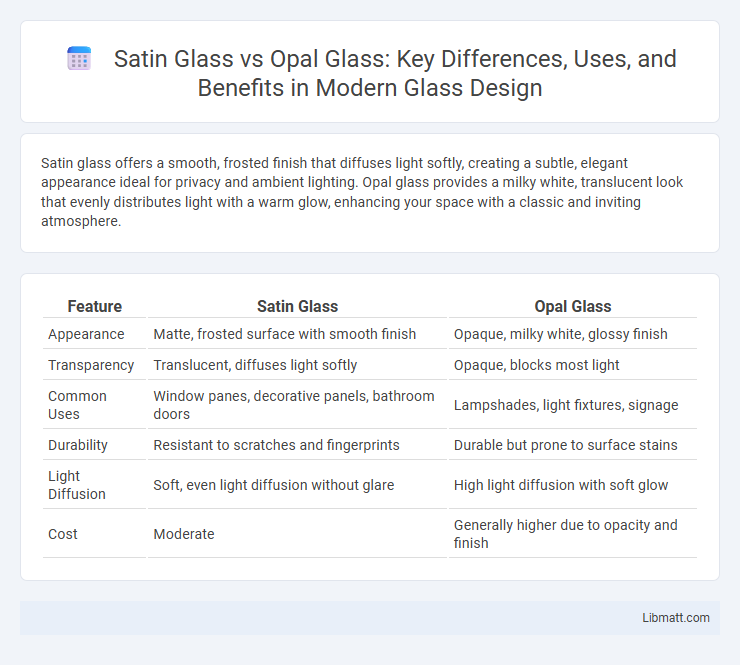Satin glass offers a smooth, frosted finish that diffuses light softly, creating a subtle, elegant appearance ideal for privacy and ambient lighting. Opal glass provides a milky white, translucent look that evenly distributes light with a warm glow, enhancing your space with a classic and inviting atmosphere.
Table of Comparison
| Feature | Satin Glass | Opal Glass |
|---|---|---|
| Appearance | Matte, frosted surface with smooth finish | Opaque, milky white, glossy finish |
| Transparency | Translucent, diffuses light softly | Opaque, blocks most light |
| Common Uses | Window panes, decorative panels, bathroom doors | Lampshades, light fixtures, signage |
| Durability | Resistant to scratches and fingerprints | Durable but prone to surface stains |
| Light Diffusion | Soft, even light diffusion without glare | High light diffusion with soft glow |
| Cost | Moderate | Generally higher due to opacity and finish |
Introduction: Satin Glass vs Opal Glass
Satin glass features a smooth, matte finish created by acid etching or sandblasting, offering a soft, diffused appearance that reduces glare and enhances privacy. Opal glass, known for its milky white translucency achieved by adding opacifying agents during production, provides uniform light diffusion ideal for lighting fixtures and decorative elements. Both materials are popular in architectural and interior design, with satin glass emphasizing texture and subtlety, while opal glass prioritizes brightness and opacity.
Understanding Satin Glass: Properties and Features
Satin glass is characterized by its smooth, frosted surface achieved through acid etching or sandblasting, providing a soft, matte appearance that diffuses light gently. It offers durability and resistance to scratches and fingerprints, making it ideal for decorative applications and privacy screens. Unlike opal glass, which is typically more translucent and milky white, satin glass maintains subtle translucency without completely obscuring shapes behind it.
What is Opal Glass? Key Characteristics
Opal glass is a type of opaque or translucent glass characterized by its milky white appearance, achieved by adding opacifiers such as tin oxide or bone ash during manufacturing. Key characteristics include its high diffused light transmission, smooth surface texture, and excellent durability, making it ideal for lighting applications and decorative purposes. Unlike satin glass, opal glass provides greater light diffusion and brightness, often used in lampshades and optical instruments.
Manufacturing Processes: Satin Glass vs Opal Glass
Satin glass is produced by acid etching or sandblasting clear glass to create a smooth, frosted surface, enhancing light diffusion while maintaining some transparency. Opal glass, on the other hand, is made by adding opacifying agents such as phosphates or fluorides during the glass melting process, resulting in a fully opaque, milky white appearance. Understanding these manufacturing differences can help you select the right type of glass for your lighting or decorative needs.
Appearance and Aesthetic Differences
Satin glass features a smooth, matte finish that diffuses light softly, creating a subtle, elegant appearance ideal for modern interiors. Opal glass, often milky white and translucent, provides a brighter, more uniform glow that enhances ambient lighting with a classic, polished look. Your choice between satin and opal glass will impact the atmosphere by emphasizing either understated sophistication or luminous clarity.
Light Diffusion and Transparency Comparison
Satin glass features a smooth, frosted surface that diffuses light evenly, reducing glare while maintaining a level of semi-transparency that allows soft shapes and colors to be visible. Opal glass, composed of a milky white, opaque material, provides superior light diffusion by scattering light more uniformly but offers significantly lower transparency, obscuring distinct objects behind it. This makes satin glass ideal for applications requiring privacy with some visibility, whereas opal glass excels in delivering consistent, soft illumination without transparency.
Common Applications in Interior Design
Satin glass is commonly used in interior design for creating privacy panels, shower enclosures, and decorative partitions due to its smooth, frosted finish that diffuses light without compromising brightness. Opal glass finds frequent application in lighting fixtures, such as lampshades and ceiling lights, where its translucent quality provides soft, even illumination ideal for ambient lighting. Both materials enhance aesthetic appeal while serving functional purposes in residential and commercial spaces.
Durability and Maintenance Factors
Satin glass offers higher durability with better resistance to scratches and everyday wear, making it ideal for high-traffic areas. Opal glass requires more delicate care due to its softer surface, which is prone to chipping and staining over time. Your choice between these materials should consider how much maintenance you are willing to commit to for long-lasting appearance and performance.
Cost Considerations: Which is More Affordable?
Satin glass generally offers a more affordable option compared to opal glass, making it popular for budget-conscious projects. The manufacturing process of satin glass involves sandblasting or acid etching, which is less expensive than the complex production required for opal glass's translucent, milky finish. Evaluating your design needs alongside cost considerations helps determine which glass type delivers the best value for your investment.
Choosing the Right Glass: Factors to Consider
Choosing between satin glass and opal glass depends on factors such as light diffusion, privacy, and aesthetic appeal. Satin glass offers a smooth, matte finish that diffuses light softly while maintaining some translucency, making it ideal for spaces requiring subtle privacy. Opal glass, characterized by its milky white appearance, provides a higher degree of light diffusion and privacy, suitable for applications like lighting fixtures and decorative panels.
Satin glass vs opal glass Infographic

 libmatt.com
libmatt.com